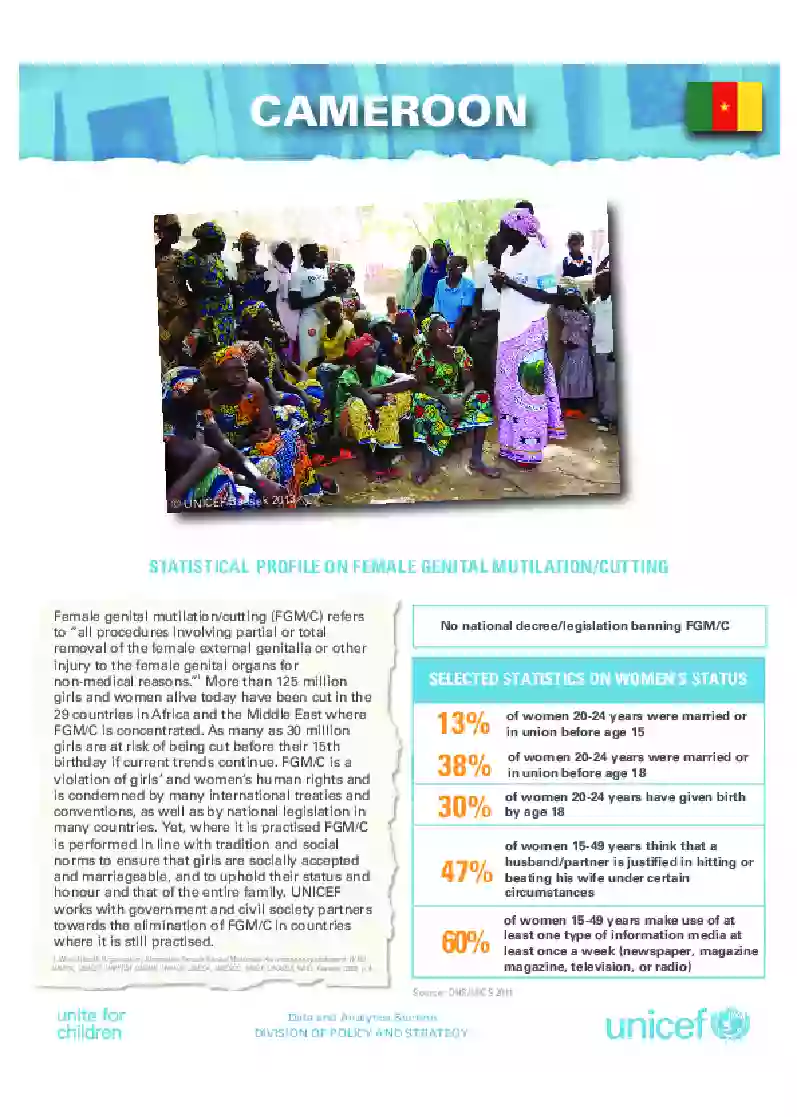Home | Research & Resources | Cameroon
Key Findings
In 2004, the prevalence of FGM/C among women in Cameroon aged 15–49 was 1.4%.
84.1% of women and 84.6% of men who have heard of FGM/C believe it should be discontinued.
Geography
The highest prevalence is found in the far north, at 5.4%
Age
Data suggests FGM/C is most likely to be performed between the ages of five and nine
Type
‘Cut, flesh removed’ is the most common type of FGM/C practised
Agent
89% of girls/women are cut by traditional midwives/birth attendants
Distribution of FGM/C across Cameroon
The region and the ethnic group with the highest prevalence are Extrême-Nord, at 5.4%, and the Arabe-Choa/Peulh/Maoussa/Kanuri, at 12.7%, although the low numbers of women in the survey who have undergone FGM/C make figures further broken down by region and ethnic group somewhat unreliable. FGM/C is more prevalent among women who practise Islam (5.8%) than among women of other religions, and among women who live in rural areas (2.1%) than among those who live in urban areas (0.9%). The prevalence in the capital city of Yaoundé is also 0.9%.
70.4% of men and more than half of women who have heard of FGM/C see no benefit in it. The higher the level of education a person has received, the more likely they are to hold the opinion that FGM/C has no benefits. 84.1% of women and 84.6% of men who have heard of FGM/C believe it should be discontinued, but 8.1% of women and 3.9% of men think it is required by their religion.
To date, there is not enough data available on FGM/C in Cameroon to determine any reliable trends.
FGM/C Legislation in Cameroon
In July 2016 the Penal Code of Cameroon was amended to include a reference to 'genital mutilation'. Section 277 states, ‘Whoever permanently deprives another of the use of the whole or any part of any member, organ or sense shall be punished with imprisonment from 10 (ten) to 20 (twenty) years.’ There is a lack of evidence, however, of any FGM/C cases being prosecuted under this law.
Development Indicators
Population Growth
29,438,320 (as at 24 September 2024), with a 2.71% growth rate (2024)
Infant Mortality
26 deaths per 1,000 live births (2021)
Maternal Mortality
438 deaths per 100,000 live births (2020)
SDG Gender Index
Ranked 136 out of 166 countries (2023)


.webp)
_cover.webp)
_french_cover.webp)
_cover.webp)
_french_cover.webp)
.webp)
_french.webp)

_cover.webp)